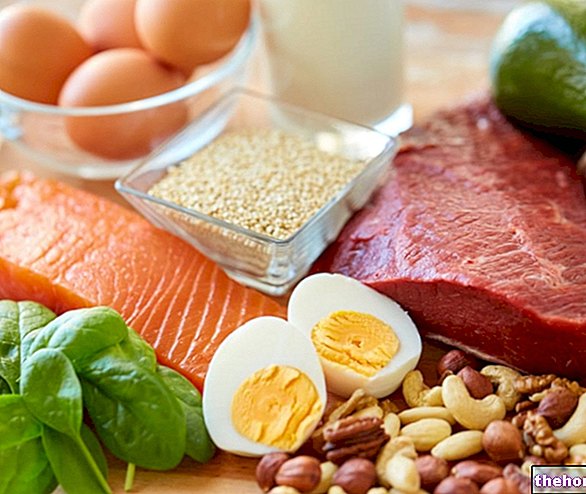Generality
Sandwich is the name by which the Anglo-Saxons call our "stuffed sandwich", hot or cold and with any type of filling.

The main characteristics of the sandwich are the ease and speed of preparation and consumption, aspects that place it in the group of fast-food foods (and, sometimes, even among junk foods). The use of the sandwich is therefore frequent in secondary meals, in frugal lunches, in school catering, in the workplace and also in the recreational ambit.
It is curious to note how sandwiches have entered Italian culture to satisfy the need for a quick meal (both in preparation and in consumption) and at the same time nutritious, economical and not dirty ... while, to date, their consumption is increasingly oriented towards buying in bars and fast-food restaurants. This change in habits can be interpreted in two ways: the first is that both time and economic resources continue to decrease (a sandwich - considering the preparation time, washing dishes, cutlery, pots, etc. - often costs less than a dish of seasoned dry pasta!); the second is that the Italian population is gradually becoming lazy, inexorably losing the gastronomic and food culture of the Bel Paese.
Historical Notes and Distribution
The sandwich takes its name from its area of origin, therefore Sandwich, a city in Kent that rises on the River Stour, near the English Channel (Great Britain - United Kingdom). The "inventor of the sandwich" properly so-called was Count Lord John Montagu (1700 AD) who, during his recreational activities, used to have sandwiches made with meat to be eaten without cutlery.
From purely Anglo-Saxon origins, starting from the 17th century AD, the TERM sandwich spread throughout the planet, easily reaching America, Asia and Africa. Although improperly, today sandwiches from the origins are also considered much older; a particularly indicative example is the typical Turkish sandwich dürüm-kebab, while the most famous American sandwiches are the hamburger and the hot dog (both from the United States). In the UK and Australia, sandwiches only mean sandwiches made from whole and divided loaves, while those made from sliced bread are known as Roll. In Italy, in addition to the classic stuffed sandwiches, there is a type of sandwich called tramezzino, prepared with pan carrè; the name was coined by Gabriele D "Annunzio (superomist and nationalist poet), in an attempt to totally eliminate international nouns from the Italian vocabulary. In Brittany, sandwich is often called Butty, due to the collective habit of spreading butter on slices of toast to be stuffed; in the same area the term Sarnie, while in Scotland the sandwich can be called dialectically Piece (translated: piece) and in Australia Sanger.
As long as it is layered, the sandwich can also brilliantly play the role of dessert. It is characterized by an open casing filled with other ingredients, such as the brioche filled with ice cream or the biscuit sandwich (or sponge cake) with butter, hazelnut, jam etc. cream.
NB. The Wall Street Journal described the sandwich as "Britain's greatest contribution to world gastronomy".
Disputes
Sandwich is a particularly simple food. There are two basic ingredients: bread and stuffing, the latter in turn represented by one or more elements of various kinds.
All over the world, a sandwich can be understood as a single covered slice of bread, or two or more stuffed slices ... on the other hand, this is not true in Massachusetts (USA). Here, the Boston court ruled that " the term "sandwich" means a preparation having AT LEAST TWO slices of bread; under this definition, the Court considers that the term "sandwich" should not include Burritos, i tacos and i quesadillas, generally made up of ONE tortilla and stuffed with a filling of meat, rice and beans ».
Com "is easily deducible, the sentence ended a dispute between two restaurateurs: a burritos seller and a sandwich seller, both tenants inside the same shopping center. The entrepreneur who proposed the sandwiches should have enjoyed a "NON COMPETITION" contractual clause within the same building, but this was questioned with the opening of the burritos company. Obviously, this situation made it necessary to distinguish between sandwiches and other similar products.
Types of Sandwich
It is therefore clear that the sandwich is an extremely heterogeneous food, and that there are as many versions as there are personal tastes of human beings. However, even for sandwiches there are "winning" recipes that have prevailed over the other proposals. merit, below we summarize the most famous stuffed sandwiches in the world:
- BLT (acronym for: Bacon, Lettuce and Tomato): is a type of bacon sandwich. The BLT consists of five ingredients: bacon, lettuce, tomato, mayonnaise and bread. The BLT is the "evolution of the classic" tea sandwich "(typically Anglo-Saxon moment that corresponds to our" snack ").
- Cheese sandwich: it is a sandwich with one or more varieties of cheeses on each slice of bread. In addition to this, it can also include toppings such as butter or mayonnaise. These sandwiches can be cold or heated in order to melt the dairy product; if they contain meat they are generally indicated with more specific names.
- Dagwood sandwich: it is a multilayer made with different varieties of meats, cheeses and condiments.
- French dip: in American cuisine represents a "French alternative. E" a hot sandwich consisting of thinly sliced roast beef (or, sometimes, other meats) on French bread (usually a baguette). It should be served au jus ("with juice"), ie with the beef juice obtained from the cooking process. Despite the term, this American specialty is almost completely unknown in France; the name therefore seems to refer to the style of bread rather than to an alleged French origin.
- Hamburger: see the dedicated article.
- Monte Cristo sandwich: is a sandwich with ham and fried cheese, a variant of the Croque Monsieur French. In 1930-1960, American cookbooks cited several recipes for this sandwich, with names like "French Sandwich". Generally, Emmental or Goviera are used for its preparation.
- Muffuletta: it is both a type of Sicilian sesame bread and a popular sandwich that uses this raw material and originates from Italian immigrants in New Orleans (Louisiana).
- Peanut Butter and Jelly Sandwich (PB&J): It is very popular in North America and includes a layer of peanut butter and jelly or jam on bread, commonly (but not necessarily) between two slices. According to a 2002 survey, the average American eats 2,500 of these sandwiches before graduating from high school.
- Philadelpia cheesesteak: Also known as philly cheesesteak and cheesesteak sandwich, it is a sandwich with steak and melted cheese, closed in a long roll, then cut into pieces.
- Pilgrim sandwich: translated, pilgrim or puritan; originated as a recycling of Thanksgiving leftovers and usually contains: roast turkey, blueberries or cranberry sauce and cheddar cheese.
- Po "boy: It's a Louisiana sandwich. It almost always consists of meat (roast beef) or fried fish. The meat is served in a baguette like in French New Orleans.
- Reuben: This is a hot sandwich with corned beef, Swiss cheese, Russian sauce and sauerkraut.
- Sloppy joe: This is a bun native to the United States consisting of ground beef, onion, tomato sauce or ketchup, and other condiments, served in a burger bun.
- Submarine (submarine) sandwich: is a sandwich that consists of a long roll of Italian or French bread filled with a variety of meats, cheeses, vegetables, toppings and sauces. The sandwich does not have a standard name, and many regions of the United States have their own definition.
Nutritional Relief
Sandwiches have a variable content depending on the recipe. To understand the extent of the differences between the various products, it is enough to compare a Double Hamburger with a Pita Bread stuffed with grilled vegetables!
Calculate the calories of your favorite sandwich
In general, the sandwich is a food that can be an excellent product or a bad alternative, depending on the context and the ingredients used.
If made up of low-fat bread, preferably fresh and with a crust, and stuffed with products that are equally low in fat and high in fiber (better if not salty), the sandwich is an EXCELLENT food for secondary meals. On the contrary, consuming sandwiches stuffed with cold cuts (or fatty meats), sauces and fatty cheeses, enclosed in a soft preserved bread, facilitates the immoderate increase in calories, saturated lipids, cholesterol and sodium (with a low satiating power! ).
Furthermore, the habit of replacing lunch with a sandwich is an incorrect and uneducative behavior for growing subjects. A single sandwich does not allow to distinguish the flavors, it gives the idea of eating little and, frequently, creates a deficit caloric then SUPERcompensated by the evening meal. In short, it is one of the main reasons for weight gain despite having the impression of "being on a diet".
Sandwiches are very convenient and useful foods when used in secondary meals, as long as they are made from genuine ingredients. However, they cannot (and must not) replace a main meal, especially if filled with unhealthy and high-calorie ingredients.
Vegan sandwich
Vegan sandwich
Problems with playing the video? Reload the video from youtube.
- Go to the Video Page
- Go to the Video Recipes Section
- Watch the video on youtube























-nelle-carni-di-maiale.jpg)




